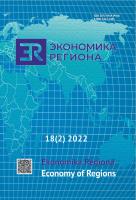Efficiency of the Education System (Primary, Secondary and Tertiary) in Particular Voivodeships of Poland
Efficiency of the Education System (Primary, Secondary and Tertiary) in Particular Voivodeships of Poland
Author(s): Łukasz Brzezicki, Piotr Pietrzak, Małgorzata CiecioraSubject(s): Economy, Geography, Regional studies, School education, Higher Education
Published by: Институт экономики Уральского отделения Российской академии наук
Keywords: efficiency; lower education; primary education; secondary education; tertiary education; higher education; DEA method; labour market; voivodeship; Poland;
Summary/Abstract: The reform of the Polish education system (both lower and higher education) that was carried out in recent years has shown the need to improve the efficiency of schools. Therefore, it is reasonable to analyse and evaluate the efficiency of educational centres before implementing reforms. Educational units influence the development of human capital, which should translate into an increase in the wealth of a given region. To our knowledge, there is a lack of research on the technical efficiency of the primary, secondary and tertiary education systems in particular Polish voivodeships. Therefore, the aim of this paper was to present the results of studies on the efficiency of the three levels of the Polish education sector in 2016. The non-radial Slack-Based Directional Distance Function (SBDDF) model, which belongs to the nonparametric Data Envelopment Analysis (DEA) method, was used to test the efficiency. The number of teachers employed in particular voivodeships, as well as the number of schools and universities were assumed as inputs. The number of pupils and students was assumed as outputs. We hypothesise that there is a positive correlation between the efficiency of the education system and the labour market economic indicators in the province. The hypothesis was verified positively as the findings showed that the higher the education system efficiency indicator in a given voivodeship, the greater the number of the SME sector companies per 10,000 inhabitants, the higher the gross Domestic Product (GDP) per capita and the lower the percentage of the unemployed in the region. The study results may be of use to various groups of stakeholders, in particular, employees of ministries responsible for the functioning of primary, secondary and tertiary education. The limitations of the study concern the selection of variables adopted on the input and output side. Moreover, the conducted analysis is static (in one year). Therefore, there is a need to continue research using a dynamic approach.
Journal: Экономика региона
- Issue Year: 18/2022
- Issue No: 2
- Page Range: 494-508
- Page Count: 15
- Language: English

